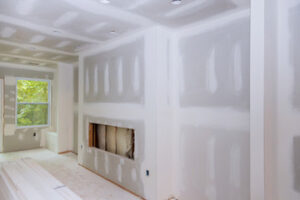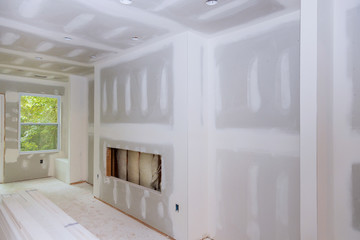Drywall is pretty sturdy stuff, but it’s not indestructible. Even so, small dents and holes in walls are relatively easy to fix for those willing to tackle the project themselves.
It’s always a good idea to locate wall studs before beginning any type of Drywall Repair Las Vegas to avoid hitting plumbing or electrical wires. Getting this step right makes the rest of the job much easier.
Despite being pretty tough, drywall isn’t immune to damage. Scratches, marks, and dents are common in many homes—either from kids, furniture, or the occasional doorknob slam. Luckily, fixing a dent in drywall is fairly simple.
For minor dents that are less than 1/2 inch wide, fill them with a thin layer of drywall compound, known in the trade as “mud.” Apply it using a plastic putty knife (not a wood knife) and smooth it till it’s flush with the wall. If you’re a homeowner, you can buy a handy-dandy drywall patch kit that has all the tools and materials you need.
Before spackling, use metal snips to cut a section of new corner bead to fit the repair area. Place it in the corner, then apply a coat of joint compound over it and let it dry. Repeat as needed until the crack is fully repaired.
Larger dents can be fixed with a little more work. First, sand down the edges of the damaged drywall to make sure it’s smooth and level with the rest of the surface. You may also need to scrape away any textured or blemished areas that are causing the dents.
After sanding, it’s important to prime and paint the patched area so that it blends in with the surrounding drywall. Choose a paint color that matches your walls as closely as possible to ensure the drywall repair isn’t noticeable.
A small crack in the drywall is another problem that’s easy to fix. If it’s only cosmetic, it might not bother you too much, but if the crack is causing a tripping hazard or letting in moisture, it’s worth addressing.
To repair a crack, remove the existing tape and apply a fresh piece. If the crack is extending through both pieces of drywall, use a utility knife to cut away any stray paper that sticks up above the seam. If it’s only a few inches long, you might be able to cover it with some joint compound and call it good.
If the crack extends down to or past the studs, you’ll need to install a new piece of drywall. This is more extensive than a patch and requires measuring, cutting, and installing the new drywall, taping the seams, and applying a final coat of joint compound. If you’re not comfortable with this type of work, consider hiring a licensed interior house painting contractor to do the job for you.
Cracks
Cracks in drywall are a common occurrence and one that many homeowners find frustrating. Usually, the crack is caused by shifting or fluctuations in the wall and can be prevented with proper installation techniques. If you’ve tried to fix a drywall crack and it keeps coming back, it’s likely that you didn’t give it enough strength and support. To repair a cracked section of drywall, use an electronic stud finder to locate the studs on both sides of the affected area and cut away the damaged portion using a drywall saw or reciprocating saw. Cut the board 3–4 inches longer than necessary to provide room for reinforcement.
If the crack is directly in the middle of a seam, install a piece of mesh drywall tape across the entire length of the crack. This will reinforce the wall, reduce shifting, and prevent future cracks in that area. After installing the tape, apply a thick bed of patch compound with a putty knife, smoothing it over the tape and into the surrounding areas. Sand it lightly and apply a second coat to make sure it’s completely even with the rest of the wall.
For cracks near the ends of a sheet or in unfinished corners, lay a 1/8-in.-thick layer of patch drywall compound over the surface, embedding the paper tape in it with a flexible knife. Smooth the compound over the tape and into the adjacent edges with a putty knife, feathering it out to help the repairs blend into the rest of the wall.
Once the patch is dry, prime and paint it to match the rest of the wall. Small blemishes can be covered with touch-up paint, but larger cracks may require repainting the entire wall.
As new homes settle over time, some homeowners notice drywall seam cracks appearing in the walls. To fix these, first prime the cleared area and any adjacent areas. Then, apply a spray can of drywall texture to the clear area and blend it into the intact wall texture.
Holes
Many homeowners will need to repair holes in their drywall at some point. Sometimes these are small and can be patched with a self-adhesive drywall patch from a hardware store; other times they may need to be framed in with wood lath. The first step is to evaluate the scope of the hole. In the case of a large hole, this requires removing the damaged drywall and inspecting the wall behind it. If there are utility wires or pipes, they will need to be marked with a pencil or pen so that they can be relocated during the drywall repair process.
Small holes from nails and screws are within the ability of most DIYers to manage with a basic drywall patch kit, a putty knife, and sandpaper or a sanding block. Once the drywall compound has cured, it can be lightly sanded to blend in with the surrounding wall surface and then repainted. You will likely need to prime the new patch if you are using high-gloss paint to ensure it does not show through.
Another common type of drywall damage that should be repaired immediately is water damage. Leaks from roofs or pipes or a sudden flood can cause the drywall to become soft and discolored and can also lead to mold growth. Not only is mold unsightly, but it can also irritate allergies and even be harmful to those with preexisting health conditions.
The best way to prevent further damage is to have a professional inspect the drywall for signs of mold and water damage, then make any necessary repairs right away. This is especially important when you notice a musty smell or see discoloration in the drywall, which are often indicators of hidden mold buildup.
If you need to repair a hole in drywall that is larger than 4 inches across, you will need to frame the area with wood strips. Use a stud finder to locate the center of the nearest stud on either side of the hole, then mark their position with a pencil or pen. Cut two pieces of wood lath a few inches longer than the height of the wall, then screw them into place. Place one lath vertically on each side of the hole, then cut and fit a drywall patch to the hole, securing it to the drywall with drywall screws.
Nail Pops
A few nail pops in interior walls or ceilings are normal and nothing to worry about. However, if you notice them in large numbers spread over the entire surface of your walls or ceiling, they are not good for the look. These protrusions are caused by drywall nails or screws that have popped out of their proper place in the wall or ceiling. Luckily, they are easy to fix.
Often, nail pops occur because the drywall moves or shifts while the stud or screw that holds it in place remains stationary. This can be a result of changes in temperature or humidity, movement in the house from settling, or a combination of these factors. The wood studs also shrink and lose their grip on the smooth shank of a nail or screw, which allows it to slip free from its position in the stud. This results in the nail or screw pushing up through the drywall and marring the surface of the wall or ceiling.
If you notice a lot of nail pops in one area of the house, it’s a sign that there is a problem with the structure, and you should consult with a structural engineer. Otherwise, it’s a simple fix for any do-it-yourselfer to tackle.
Start by locating the nail or screw, which should be evident due to the protruding blob of drywall compound or paint that has formed around it. You may need to dig through this blob with the blade of your putty knife to get to the nail or screw. Once you do locate it, you can simply remove the nail or screw with pliers or a drill. Once you’ve removed the nail or screw, add a new screw that is an inch or two longer than the original. This will prevent the nail or screw from working its way back through the drywall again in the future.
After adding the new drywall screw, apply another thin layer of joint compound to the affected area and smooth it with your putty knife. After it dries, give the repaired area a light sanding to create a smooth surface before painting.
